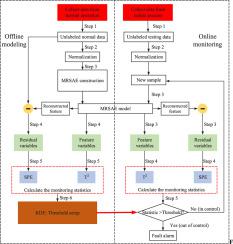当前位置:
X-MOL 学术
›
J. Process Control
›
论文详情
Our official English website, www.x-mol.net, welcomes your
feedback! (Note: you will need to create a separate account there.)
Manifold regularized stacked autoencoders-based feature learning for fault detection in industrial processes
Journal of Process Control ( IF 3.3 ) Pub Date : 2020-08-01 , DOI: 10.1016/j.jprocont.2020.06.001 Jianbo Yu , Chengyi Zhang
Journal of Process Control ( IF 3.3 ) Pub Date : 2020-08-01 , DOI: 10.1016/j.jprocont.2020.06.001 Jianbo Yu , Chengyi Zhang

|
Abstract Multivariate statistical process control (MSPC) has been widely employed for process fault detection. Recently, deep neural networks (DNNs), i.e., stacked autoencoder (SAE) enjoys its popularization in process fault detection. SAE shows good performance in extracting representative features from the process data based on unsupervised learning, which provides a new monitoring method without large amount of labeled data. However, the extraction of the intrinsic geometrical information from process signals is not considered by these regular SAEs This paper proposes a new DNN, manifold regularized stacked autoencoders (MRSAE) for fault detection in complex industrial processes. The local/global information preservation is incorporated into the encoding phase of SAE to capture intrinsic structure of the process data. MRSAE is used to describe distribution of the nonlinear process data and learn effective features for process fault detection. Two typical statistics (i.e., Hotelling’s T-squared ( T 2 ) and squared prediction error (SPE)) based on the extracted features by MRSAE are developed for process fault detection. The comparison between MRSAE and other typical DNNs on a complex numerical process and two benchmark processes, i.e., Tennessee Eastman process (TEP) and Fed-Batch fermentation penicillin process (FBFP), indicates the effectiveness of the proposed method for process fault detection. The manifold regularization-based DNN technique provides a new way for feature learning from high-dimensional and nonlinear process signals.
中文翻译:

基于流形正则化堆叠自编码器的特征学习用于工业过程中的故障检测
摘要 多元统计过程控制(MSPC)已被广泛用于过程故障检测。最近,深度神经网络(DNN),即堆叠自编码器(SAE)在过程故障检测中得到了普及。SAE在基于无监督学习的过程数据中提取代表性特征方面表现出良好的性能,提供了一种无需大量标记数据的新监测方法。然而,这些常规 SAE 并未考虑从过程信号中提取内在几何信息。 本文提出了一种新的 DNN,流形正则化堆叠自编码器 (MRSAE),用于复杂工业过程中的故障检测。本地/全局信息保存被纳入 SAE 的编码阶段,以捕获过程数据的内在结构。MRSAE用于描述非线性过程数据的分布并学习过程故障检测的有效特征。基于 MRSAE 提取的特征,开发了两种典型的统计数据(即 Hotelling 的 T 平方 (T 2 ) 和平方预测误差 (SPE))用于过程故障检测。MRSAE 与其他典型 DNN 在复杂数值过程和两个基准过程(即田纳西伊士曼过程(TEP)和分批发酵青霉素过程(FBFP))上的比较表明所提出的过程故障检测方法的有效性。基于流形正则化的 DNN 技术为从高维和非线性过程信号中学习特征提供了一种新方法。、基于 MRSAE 提取的特征的 Hotelling T 平方 (T 2 ) 和平方预测误差 (SPE)) 被开发用于过程故障检测。MRSAE 与其他典型 DNN 在复杂数值过程和两个基准过程(即田纳西伊士曼过程(TEP)和分批发酵青霉素过程(FBFP))上的比较表明所提出的过程故障检测方法的有效性。基于流形正则化的 DNN 技术为从高维和非线性过程信号中学习特征提供了一种新方法。、基于 MRSAE 提取的特征的 Hotelling T 平方 (T 2 ) 和平方预测误差 (SPE)) 被开发用于过程故障检测。MRSAE 与其他典型 DNN 在复杂数值过程和两个基准过程(即田纳西伊士曼过程(TEP)和分批发酵青霉素过程(FBFP))上的比较表明所提出的过程故障检测方法的有效性。基于流形正则化的 DNN 技术为从高维和非线性过程信号中学习特征提供了一种新方法。田纳西伊士曼工艺 (TEP) 和补料分批发酵青霉素工艺 (FBFP) 表明了所提出的工艺故障检测方法的有效性。基于流形正则化的 DNN 技术为从高维和非线性过程信号中学习特征提供了一种新方法。田纳西伊士曼工艺 (TEP) 和补料分批发酵青霉素工艺 (FBFP) 表明了所提出的工艺故障检测方法的有效性。基于流形正则化的 DNN 技术为从高维和非线性过程信号中学习特征提供了一种新方法。
更新日期:2020-08-01
中文翻译:

基于流形正则化堆叠自编码器的特征学习用于工业过程中的故障检测
摘要 多元统计过程控制(MSPC)已被广泛用于过程故障检测。最近,深度神经网络(DNN),即堆叠自编码器(SAE)在过程故障检测中得到了普及。SAE在基于无监督学习的过程数据中提取代表性特征方面表现出良好的性能,提供了一种无需大量标记数据的新监测方法。然而,这些常规 SAE 并未考虑从过程信号中提取内在几何信息。 本文提出了一种新的 DNN,流形正则化堆叠自编码器 (MRSAE),用于复杂工业过程中的故障检测。本地/全局信息保存被纳入 SAE 的编码阶段,以捕获过程数据的内在结构。MRSAE用于描述非线性过程数据的分布并学习过程故障检测的有效特征。基于 MRSAE 提取的特征,开发了两种典型的统计数据(即 Hotelling 的 T 平方 (T 2 ) 和平方预测误差 (SPE))用于过程故障检测。MRSAE 与其他典型 DNN 在复杂数值过程和两个基准过程(即田纳西伊士曼过程(TEP)和分批发酵青霉素过程(FBFP))上的比较表明所提出的过程故障检测方法的有效性。基于流形正则化的 DNN 技术为从高维和非线性过程信号中学习特征提供了一种新方法。、基于 MRSAE 提取的特征的 Hotelling T 平方 (T 2 ) 和平方预测误差 (SPE)) 被开发用于过程故障检测。MRSAE 与其他典型 DNN 在复杂数值过程和两个基准过程(即田纳西伊士曼过程(TEP)和分批发酵青霉素过程(FBFP))上的比较表明所提出的过程故障检测方法的有效性。基于流形正则化的 DNN 技术为从高维和非线性过程信号中学习特征提供了一种新方法。、基于 MRSAE 提取的特征的 Hotelling T 平方 (T 2 ) 和平方预测误差 (SPE)) 被开发用于过程故障检测。MRSAE 与其他典型 DNN 在复杂数值过程和两个基准过程(即田纳西伊士曼过程(TEP)和分批发酵青霉素过程(FBFP))上的比较表明所提出的过程故障检测方法的有效性。基于流形正则化的 DNN 技术为从高维和非线性过程信号中学习特征提供了一种新方法。田纳西伊士曼工艺 (TEP) 和补料分批发酵青霉素工艺 (FBFP) 表明了所提出的工艺故障检测方法的有效性。基于流形正则化的 DNN 技术为从高维和非线性过程信号中学习特征提供了一种新方法。田纳西伊士曼工艺 (TEP) 和补料分批发酵青霉素工艺 (FBFP) 表明了所提出的工艺故障检测方法的有效性。基于流形正则化的 DNN 技术为从高维和非线性过程信号中学习特征提供了一种新方法。











































 京公网安备 11010802027423号
京公网安备 11010802027423号